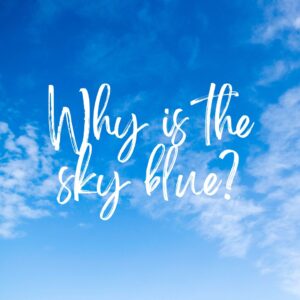If you’ve ever looked up at the sky and wondered why is the sky blue? There are three primary reasons why the sky appears blue. First, when sunlight passes through the atmosphere, it reflects off of air molecules back to our eyes, so we see a blue tint as opposed to straight white light. Second. All of the other colors are absorbed by the molecules in the atmosphere except blue. Thus it gives us that gorgeous azure color we’re accustomed to seeing.
How does scattering occur?
The gaseous particles and molecules present in the atmosphere scatter the sunlight. Rayleigh scattering, a type of optical scattering, can happen when light particles (photons) scatter from molecules all over the atmosphere that is much smaller than themselves. The effect increases with shorter wavelengths, so shorter ultraviolet wavelengths are scattered more strongly than visible blue light. The remaining visible spectrum is what we see as color.
Blue light has the shortest wavelength, so most of it is scattered away first. What remains may be violet or red depending on how far up you go in the atmosphere where different atoms scatter light differently. The higher you go, the more intense the reds and violets will appear because there is less scattering. If you were to get even higher, eventually the only colors left would be purple and deep indigo since even reds have been scattered away at this point.
At these heights, you would experience a phenomenon called airglow – an aurora-like display that occurs around 200 miles above Earth’s surface. Airglow emits mainly long-wavelength light (light with lower energy), including reds, oranges, and yellows.
The Atmosphere
The atmosphere on Earth consists of nitrogen, oxygen, and other trace gases. As the sun moves across the sky, different atmospheric molecules become dominant at different altitudes in the atmosphere. Sunlight must pass through many layers of these molecules before finally reaching your eye. Each molecule along this path scatters some of the sunlight back into space, making its own little contribution to color that reaches your eye.
In addition to atmospheric conditions, local pollution also plays a role in determining what colors we see at sunset or sunrise because certain pollutants can also produce their own colors when they scatter sunlight. One such pollutant is dust. Tiny particles of dust suspended in the air cause visible particles to be seen against an otherwise hazy background.
Other particles such as soot, smoke, and ash from forest fires and volcanoes can create distinct colored patterns near the horizon where particle concentrations are highest. And while you may think smoke produces browns and black colors, particles from wildfires actually create bright oranges, reds, yellows, and gold. Likewise for ash from volcanoes: gray turns into grayish blues under strong winds with higher particle concentrations.
Atoms, Electrons, and Atomic Structure
The short answer to why the sky is blue, as noted by NASA, has to do with electrons and atomic structure. The world around us appears to be colored because of light waves interacting with molecules in a material or substance, says NASA. Molecules give off light when they become excited. The type of molecule determines the color of light that it gives off when excited.
For example, oxygen molecules emit a dark reddish-purple hue when excited.
When air molecules are excited by energy from sunlight and heat from Earth, they begin to oscillate at a higher frequency than normal. Molecules tend to scatter shorter wavelength (blue) photons more than longer wavelength (red) ones. When the sun’s light hits Earth’s atmosphere, most of its blue photons scatter out toward space while most of its red and orange ones reach our eyes. Thus we see an orange sunset rather than a blue one.
On days with high humidity, however, water droplets can act like little mirrors for these shorter wavelength colors and send them back down toward earth this phenomenon causes rainbows on sunny days. Additionally, not all wavelengths are scattered equally in the same way what does get scattered will depend on how much energy each photon carries.
The infrared light given off by warm objects gets scattered about 10 times less than visible light, so cooler objects such as those found outside during early mornings will be easier to see even if the sky is still full of clouds.
What Is Rayleigh Scattering?
When you look up into the sky, you’re actually looking at what we call sky glow. But what exactly causes this phenomenon? The short answer is that light from the sun scatters off of gas molecules in our atmosphere. Specifically, when sunlight hits these molecules, most of its energy reflects back out (known as Rayleigh scattering).
However, some wavelengths absorb these molecules and emit a slightly different color. This phenomenon- known as Rayleigh scattering- explains why our skies appear blue to us on Earth. For example, here on Earth, the nitrogen molecule absorbs red and orange wavelengths of light and emits blue. In contrast, other gases like oxygen and helium don’t have such strong absorption properties. So why doesn’t everything just appear white or yellowish? Well, since not all molecules can absorb all colors equally well or scatter them equally well. Certain colors become more dominant than others.
Since nitrogen is one of the major atmospheric gases, its ability to scatter blue light better than other colors accounts for why our skies appear blue to us. Plus, there are lots of tiny bits of dust and water vapor in the air too which help scatter shorter wavelength waves making blue even brighter. And if that isn’t enough for you, remember how rainbows only show up when there’s a bright source of sunlight?
When rainbows form because water droplets act as small prisms so they let only certain wavelengths pass through while reflecting others. Usually violet, indigo, and sometimes even this means they scatter away before ever reaching your eyes!
How Diffraction Works
Light from a light source, such as the sun, can think of as waves. These waves reflect or bent after hitting an object. The light that enters our eyes will also bend or reflect when it hits an object in front of us. If we have a screen with two slits and shine a light through it onto a surface behind the screen. We’ll see two bands of color on that surface. One band is white and one is in color. What colors you see depends. Where is the position of the slit relative to your eye? If the slit’s closer to your eye. You’ll only see one band; if it’s farther away, you’ll only see one band.
This happens because there now two sets of waves bounce off of each other after they’ve diffracted either slit: those from the first set coming from each slit travel towards your eye without colliding into each other and those from the second set do collide into each other (due to being at slightly different angles). These waves interfere with each other and form alternating light/dark patterns which will form bands depending on how close together the slits are.
Add All Together
The short answer to this question is that when sunlight travels through the atmosphere, small particles in the air scatter light. The scattering happens in different ways based on how big or heavy a particle is and how far apart they are from each other. The type of scattering that makes our sky appear blue occurs when a light particle interacts with a heavier particle and causes it to produce a new light particle with less energy and a bluer color.
This process happens over and over again so that the time sunlight reaches us, most of its energy has transferred to these new particles, which we see as blue. It turns out that the reds and yellows scatter out of sunlight before it reaches us, meaning that only blue light remains to bounce off oxygen and nitrogen molecules in the air.
When you combine all these processes together. You get a clear view of why the sky is such a beautiful shade of blue! There are many explanations for why the sky is blue, but this one seems to be the most accurate. For example, when the sun sets in front of us. Rays of sunlight will reflect off other particles high up into the atmosphere before reaching Earth.
These tiny reflective particles create an array of colors that make up. We call the twilight the transitional period between night and day. Depending on where you are located on Earth and what direction you’re looking at the sunset. Twilight will vary drastically in both intensity and hue because some parts of Earth have more dust than others.
Final Thoughts
Did you know that all colors in our world create to add together two or more colors? For example, red and blue make purple. The color of the sky is no different – and when sunlight hits the atmosphere. Some colors absorb while others bounce back. Some colors can’t see as well as others. So when white light (which includes all colors) enters our atmosphere, only certain wavelengths bounce back to us.
Red and violet scatter tiny molecules in the air like oxygen or nitrogen molecules, which makes them appear bluish-purple.
Blue light travels farther than other colors. You were to view a distant object at night through a large telescope. You might see a bluer image than if you were looking during the day with your eyes.
If you look at the sun on a clear day, sometimes you’ll notice little specks of green around it. These call sunspots. Sunspots come from solar activity on the surface of the sun. They cause magnetic fields to push up against the surface layers below them. Sunspots aren’t typically visible unless the sun has a lot of them at once. But in those cases, they usually show up as a speckled haze around the edges of the sun. That’s why is the sky blue.

